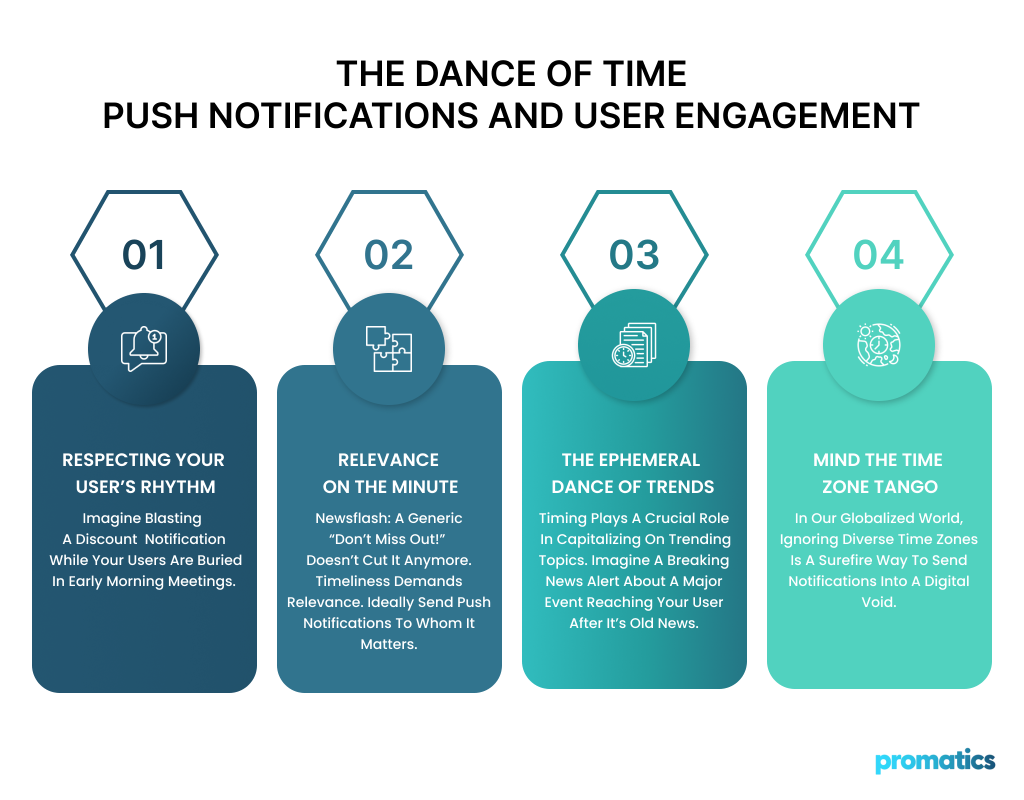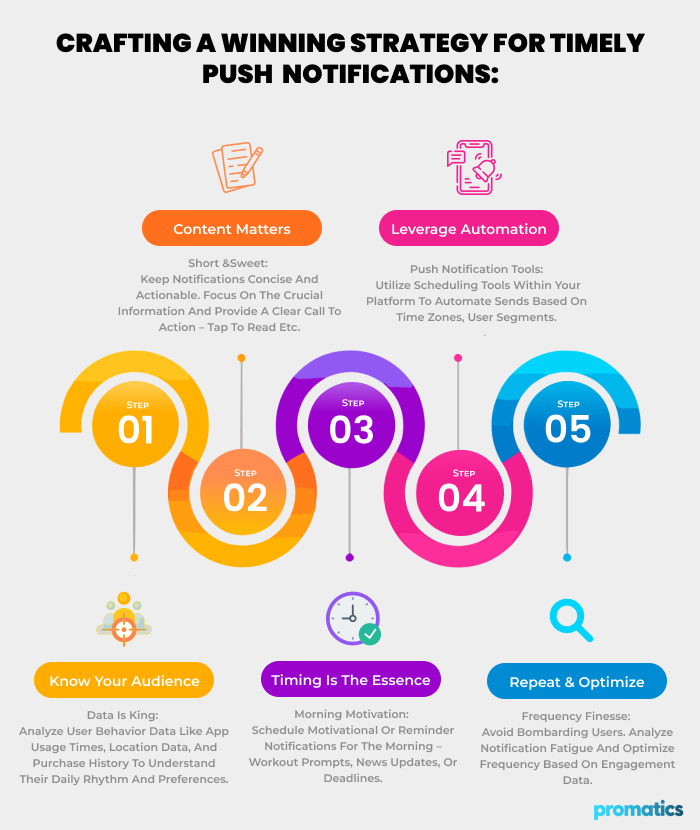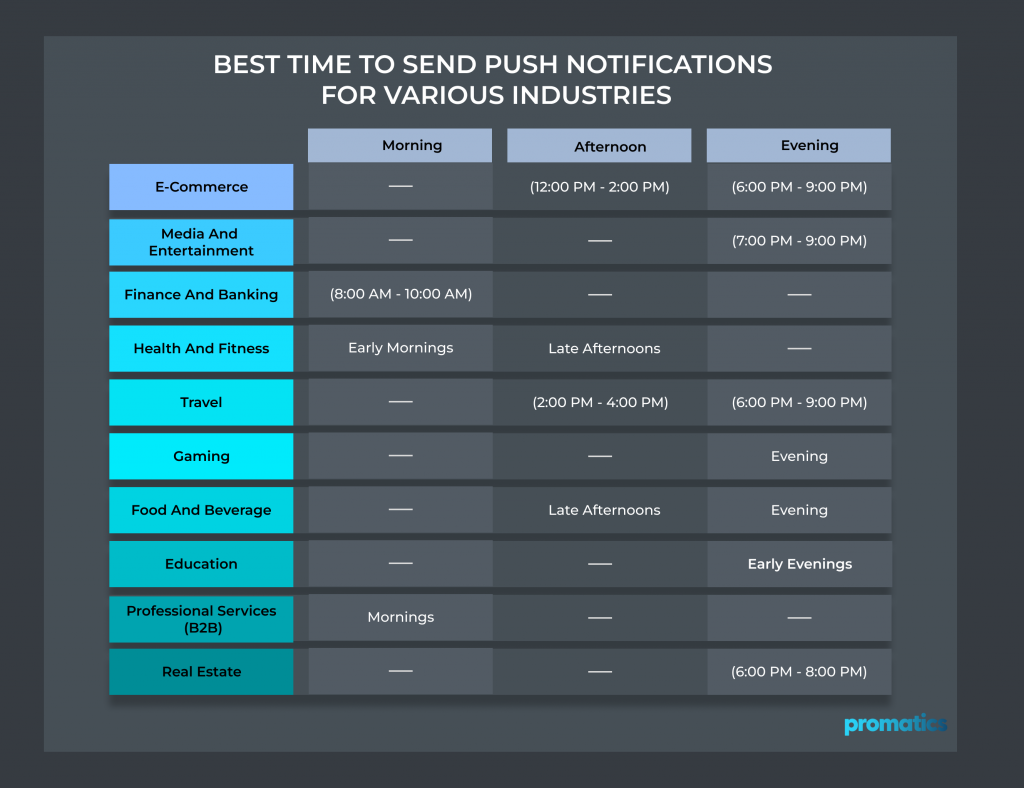How often you your app should send push notifications
Table of Contents
- The dance of time: Push notifications and user engagement
- Crafting a Winning Strategy for Timely Push Notifications
- Best time to send push notifications for various industries
- Frequency and Persona: The Push Notification Power Couple
- Frequently asked Questions
In the digital age, information bombards us from every screen, demanding instant attention. Emails pile up, social media feeds overflow, and phone notifications chirp incessantly. But amidst this cacophony, a silent messenger emerges, whispering directly into our ear: the push notification. These miniature pop-ups, bypassing the usual notification channels, cut through the digital clutter, demanding immediate action. But why is time of the essence when it comes to these fleeting messages? Imagine a flash sale expiring in minutes, a breaking news alert with life-altering consequences, or a last-minute boarding call for your dream vacation. In these scenarios, the push notification becomes a lifeline, a bridge between the digital world and our immediate needs. Missing a notification can mean missing out on an opportunity, a connection, or even a piece of critical information. This is why understanding the power of timeliness in push notifications is crucial, for it’s not just about grabbing attention; it’s about shaping our digital experiences, one well-timed notification at a time. So, buckle up, as we delve into the fascinating world of when to send push notifications, where seconds can make all the difference, and timing becomes the ultimate currency in the fight for our attention.
The dance of time: Push notifications and user engagement
Timing isn’t just a nice suggestion for push notifications; it’s a non-negotiable throne room where engagement rates get crowned and conversion metrics waltz. Sending a notification at the optimal moment is the difference between a user tapping to engage and tapping to uninstall. Let’s explore the time zones of this digital kingdom and why they matter:
1. Respecting Your User’s Rhythm: Imagine blasting a discount notification while your users are buried in early morning meetings. Not only will you disrupt their flow, but you’ll likely earn an exasperated scroll-by at best. Understanding your user’s typical schedule and habits is key. Analyze data on peak app usage, sleep patterns, and even commuting times to identify windows of receptivity. A well-timed push notification that complements their day, like a lunchtime delivery reminder or a post-work entertainment suggestion, is far more likely to be welcomed and acted upon.
2. Relevance on the Minute: Newsflash: a generic “Don’t miss out!” doesn’t cut it anymore. Timeliness demands relevance. Ideally send push notifications to whom it matters. Sending an alert about a local flash sale when your user is miles away, or promoting a weekend brunch deal on a Tuesday morning, reeks of tone-deafness. Leverage user location data, purchase history, and in-app behavior to personalize notifications. Imagine someone browsing travel blogs. Sending a notification for a discounted flight to their dream destination within minutes of their research? Bingo! You’ve tapped into their immediate interest and offered a solution at the perfect moment.
3. The Ephemeral Dance of Trends: Timing plays a crucial role in capitalizing on trending topics. Imagine a breaking news alert about a major event reaching your user after it’s already old news. The notification loses its immediacy and impact. By monitoring social media trends and analyzing real-time user behavior, you can jump on the wave of popular interest and send notifications while the topic is still sizzling hot. Think live sports updates during a nail-biting match or a flash sale for a trending fashion item right after it goes viral. Timeliness makes your brand seem in-the-know and relevant, fostering user engagement and positive brand perception.
4. Mind the Time Zone Tango: In our globalized world, ignoring diverse time zones is a surefire way to send notifications into a digital void. A well-timed notification for a New Yorker might bombard a Parisian in the middle of the night. Schedule notifications based on user location or offer time zone preferences within the app. Remember, relevance extends beyond the content of the notification; the delivery time itself needs to be culturally and geographically sensitive.Mastering the art of timeliness in push notifications time is like wielding a magic wand. It unlocks higher engagement, boosts conversion rates, and fosters user loyalty. By understanding your audience’s rhythm, prioritizing relevance, playing the trend dance, and respecting time zone waltzes, you can transform push notifications from digital blips to attention-grabbing ambassadors for your brand.
Crafting a Winning Strategy for Timely Push Notifications:
If you can send push notifications at the right moment it means half the battle is won. It is because figuring out right notifications time is no mere coincidence; it’s a strategic science. Here are some key elements to consider when crafting the best strategy for timely notifications:
1. Know Your Audience:
- Data is king: Analyze user behavior data like app usage times, location data, and purchase history to understand their daily rhythm and preferences. Segment your audience based on these insights to personalize notification timing.
- Surveys and preferences: Engage users directly through surveys or in-app settings to learn their preferred notification times and frequencies. This direct feedback provides valuable data and fosters trust.
2. Content Matters:
- Relevance reigns supreme: Tailor notification content to individual user interests and recent activity. A news update relevant to their job title or a reminder about an abandoned cart are more likely to resonate than generic messages. So, send push notifications with the content that will be actioned upon by the user.
- Short & sweet: Keep notifications concise and actionable. Focus on the crucial information and provide a clear call to action – tap to read, shop now, etc.
3. Timing is the Essence:
- Morning motivation: Schedule motivational or reminder notifications for the morning – workout prompts, news updates, or deadlines.
- Midday magic: Target lunchtime for food delivery deals, shopping reminders, or entertainment suggestions.
- Evening engagement: Cater to post-work relaxation with entertainment recommendations, flash sales, or personalized product suggestions.
- Weekends and holidays: Adapt timing to weekend or holiday schedules. A brunch offer on Saturday morning or a travel deal during holiday planning season are well-timed triggers.
In short there is no one best time to send push notifications for everyone and all types of apps.
4. Leverage Automation:
- Push notification tools: Utilize scheduling tools within your platform to automate sends based on time zones, user segments, and specific triggers like abandoned carts or product page visits.
- A/B testing: Experiment with different send times and personalize delivery based on user data to identify optimal timing for your audience.
5. Repeat & Optimize:
- Frequency finesse: Avoid bombarding users. Analyze notification fatigue and optimize frequency based on engagement data. Offer opt-out options and let users control their notification preferences. Send push notifications only when required.
- Performance tracking: Continuously monitor open rates, click-through rates, and conversions to see how your timing strategy impacts performance. Adapt and refine your approach based on real-time results.
Best time to send push notifications for various industries
The best time to send push notifications can vary across industries and even within specific niches. However, here are some general recommendations based on industry trends:
1. E-commerce:
- Weekdays, especially Tuesday through Thursday during lunch hours (12:00 PM – 2:00 PM)
- Early evening (6:00 PM – 9:00 PM) works as you can target after-work relaxation with product recommendations, personalized deals, or free shipping offers.
- Weekends can also be effective, particularly Sunday evenings when people are planning their upcoming week.
2. Media and Entertainment:
- Evenings, around 7:00 PM – 9:00 PM, when people are more likely to be relaxing and consuming content.
- Weekends can be high-engagement times for entertainment-related notifications.
3. Finance and Banking:
- Weekday mornings, especially between 8:00 AM and 10:00 AM, when users are likely to check their accounts.
- Avoid sending financial notifications late at night.
4. Health and Fitness:
- Early mornings and late afternoons are popular times, catering to users’ workout routines.
- Consider sending motivational messages in the morning and achievement reminders in the evening.
5. Travel:
- Weekday afternoons (2:00 PM – 4:00 PM) and evenings (6:00 PM – 9:00 PM) when people are more likely to be planning trips.
- When you send push notifications consider time zone differences for users planning international travel.
6. Gaming:
- Evenings and weekends are typically high-engagement times for gamers.
- Send notifications related to special events, promotions, or new releases during these peak times.
7. Food and Beverage:
- Late afternoons and evenings when people are thinking about dinner plans.
- Weekends, especially Sunday, can be a good time to send promotions for dining out or food delivery.
8. Education:
- Early evenings during the weekdays when students may be more focused on educational content.
- Avoid sending notifications during school hours.
9. Professional Services (B2B):
- Tuesday through Thursday mornings when professionals are more likely to be engaged.
- Avoid Mondays and Friday afternoons, as these times may have lower engagement.
10. Real Estate:
- Weekday evenings (6:00 PM – 8:00 PM) when people may be more relaxed and open to exploring property listings.
- Weekends, especially Sunday afternoons, can also be effective.
It’s crucial to note that these recommendations are generalizations, and the effectiveness of push notifications can vary based on your specific audience and app usage patterns. Regularly analyze user behavior and adjust your strategy accordingly to find the optimal times for your industry and target audience. A/B testing can also provide valuable insights into the most effective timing for you to decide when to send push notifications.
Frequency and Persona: The Push Notification Power Couple
Now these little pop-up messages on our phones can be a powerful tool for engagement and conversion. But like any good relationship, it’s all about balance. Sending too many notifications can turn users into annoyed exes, while sending too few leaves them feeling neglected. That’s where frequency and persona come in.
Frequency: Finding the sweet spot
Think of frequency as the number of dates you ask someone out. Too many, and you’re smothering them. Too few, and they might forget you exist. The ideal frequency for push notifications depends on several factors, like:
- Industry: E-commerce stores can get away with more frequent notifications than, say, a bank.
- Content: Urgent news updates warrant more immediate alerts than, say, weekly blog digests.
- Persona: Younger demographics might be more receptive to daily notifications than older ones. So you can send push notifications to them often.
A good rule of thumb is to start with less and gradually increase based on user engagement. Track metrics like open rates and click-through rates to see what resonates with your audience. If you’re not sure where to begin, here are some general frequency guidelines:
- E-commerce: 2-3 notifications per week
- Media & Entertainment: 1-2 notifications per day
- Travel & Tourism: 1-2 notifications per week
- Food & Delivery: 2-3 notifications per day
- Finance & Banking: 1-2 notifications per week
Persona: Knowing your audience
Just like you wouldn’t send the same love letter to your grandma as you would to your crush, your push notifications shouldn’t be one-size-fits-all. Segmenting your audience by persona allows you to tailor your messages to their specific needs and interests. Consider factors like:
- Demographics: Age, gender, location
- Interests: Shopping habits, travel preferences, media consumption
- Behavior: App usage, purchase history, click-through rates
For example, you might send a notification about a new sneaker release to your young, fashion-conscious audience, while sending a notification about a retirement planning webinar to your older audience.
Frequency and persona working together:
By combining the right frequency with the right persona, you can create push notifications that are both engaging and effective. Imagine this:
Sarah, a busy professional: She receives a lunchtime notification from her favorite food delivery app with a personalized lunch special offer. The timing is perfect, the content is relevant, and she’s more likely to click. So, for her best time to send push notifications is just before lunch time in this particular case
- David, a travel enthusiast: He gets a weekend morning notification from a travel app highlighting amazing deals on flights to his dream destination. The timing sparks his wanderlust, the content is tempting, and he’s more likely to book a trip.
Remember: It’s all about finding that sweet spot where your notifications are valuable, not valueless. By respecting your users’ time and tailoring your messages to their individual needs, you can turn push notifications into powerful tools for building long-lasting relationships with your audience.
Important tips:
- Personalize your notifications: Use users’ names, purchase history, or location to make your messages more relevant.
- A/B test different frequencies and personas: See what works best for your audience.
- Use clear and concise language: Get to the point quickly and avoid jargon.
- Always include a call to action: Tell users what you want them to do.
By following these tips, you can ensure your push notifications are always welcome guests, not unwanted interruptions.
With data insights and user behavior knowledge you can predict what is the best time to send push notifications for anyone. Crafting the best strategy for timely push notifications is an ongoing process. By understanding your audience, tailoring content, timing strategically, and utilizing automation, you can transform push notifications from annoying interruptions to valuable tools for engagement and conversion. So, experiment, analyze, and keep refining your timing – your audience will thank you for it!
Frequently asked Questions:
1.) What is the best time to send push notifications?
The best time to send push notifications varies by industry, but generally, weekdays during lunch hours or evenings tend to be effective. Consider user behavior and time zones for optimal engagement.
2.) How many push notifications per day an app should send?
An app should aim for a balance. Avoid overwhelming users; 1-2 relevant and timely notifications per day is a reasonable guideline. You must not send push notifications without a solid reason.
3.) How often to send push notifications?
The frequency of push notifications depends on user preferences and app context. Avoid being intrusive; focus on delivering valuable and timely content. Regularly analyze user engagement to fine-tune your strategy.
Still have your concerns?
Your concerns are legit, and we know how to deal with them. Hook us up for a discussion, no strings attached, and we will show how we can add value to your operations!



